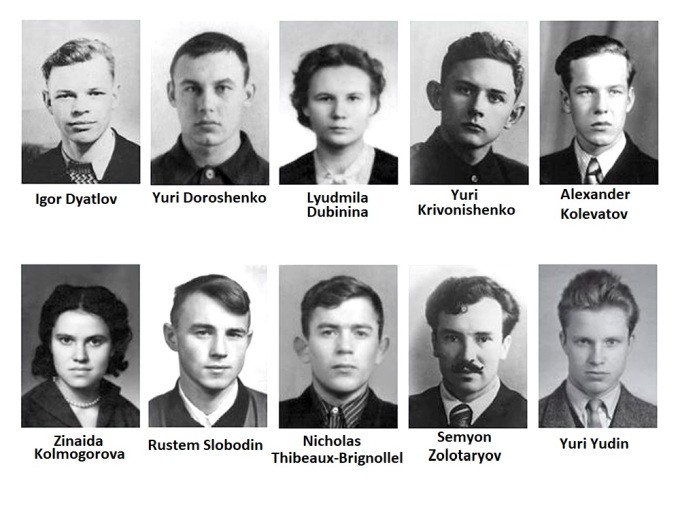How science and technology solved the 60-year-old mystery of Dyatlov Pass
The mysterious deaths of the nine Russian hikers has baffled scientists for years
Photo by Submitted
Dyatlov Pass expedition members [Public domain]
When thinking of unsolved mysteries and true crime, it’s easy to be overcome with emotion, whether it’s fear or fascination. I often find myself spending hours upon hours trying to solve the puzzle. Unfortunately, unsolved cases are rarely cracked. On the occasion these mysteries are solved, what is discovered is never what we expect.
I’m going to tell you about one such case which remained unsolved for over 60 years until state-of-the-art technology finally uncovered the mystery.
So, gather around children as I tell you the spooky story of Dyatlov Pass.
This story takes place in February of 1985 in Russia. A group of nine experienced hikers from the Ural Polytechnical Institute went trekking in the Ural Mountains. The team made camp on the slopes of “Kholat Syakl”. In English this translates to “Dead Mountain.”
Now maybe this is just me, but if I were a hiker and came across a summit called “Dead Mountain,” I wouldn’t be caught dead there. See what I did there? Just trying to lighten the mood.
Nonetheless, they made camp that night and it was the last time anyone heard from them. This is where the story gets a little sketchy.
After the hikers had been missing for two months, their bodies were found by Soviet investigators.
They determined the cause of death for six of the hikers was hypothermia, while the other three had died from some sort of physical trauma. This conclusion did not sit well with anyone for a few reasons.
First, let us discuss the scene:
- Evidence suggests the night the hikers died, something caused them to cut their way out of their tents.
- Their bodies were found scattered across the campsite in various stages of undress in subzero temperatures.
- Autopsy reports found multiple injuries on the bodies: one body had major skull damage and chest trauma, two bodies were missing their eyes and another was missing his tongue.
- Radiation was found on the bodies.
It was clear to everyone who heard the story that something big happened here. Numerous theories have been suggested such as an animal attack, military involvement, aliens and my personal favorite – a Yeti attack.
For years this case baffled even the most experienced of scientists. But in 2019, Alexander Puzin, a geotechnical engineer, teamed up with Johan Gaume, head of the Snow Avalanche Simulation Laboratory at EPFL, to create a computer model to try and replicate the incident.
The model determined that the most likely cause of death for these hikers was a small avalanche. The small size would explain why there was no evidence of an avalanche found in 1959.
This would also explain why the hikers cut their way out of their tent wearing improper clothes. The moment the avalanche hit, they were buried, forcing them to rip free from their tent. But how could an avalanche cause some of the injuries the hikers had?
To answer that, Puzin and Guame would need the help of the Disney movie animators from “Frozen.”
Yup, the animated movie “Frozen” helped solve one of Russia’s greatest mysteries. Who would have thought? Not me.
Gaume used the snow animation code used in “Frozen” for his own avalanche model to simulate an avalanche’s effect on the human body.
It is hypothesized the avalanche caused heavy snow slabs to fall from the mountain onto the hikers while they were sleeping in their tents, resulting in severe trauma.
The missing eyes and tongue were accredited to scavengers after the fact and the radiation was caused by the Thorium lanterns the hikers used. Case closed.
Although there are a few questions from the scene that are still unexplainable, an avalanche sounds a lot more likely than hypothermia and unfortunately, more likely than a Yeti attack.
As fun as it is to speculate on unsolved cases like this, it is important to know this is not a fictional story. These were real people who lost their lives.
During Guame’s research into the case, he discovered after the avalanche, three of the hikers were severely injured in their tents. But since all the bodies were found outside the tent, it is more likely the able-bodied survivors tried to drag the injured from their tents in an attempt to rescue their friends.
“This is a story of courage and friendship,” says Puzin, and thanks to these nine hikers and Guame’s model this avalanche research can help prevent other hikers from this fate.
Hinrichs can be reached at [email protected].

Allison Hinrichs is a third-year journalism and multimedia communication student. This is her fourth semester at The Spectator. Allison loves being outdoors and anything that gives her an adrenaline rush. She loves hiking, rock climbing, snowboarding and photography.












Glenn Mitchell • Feb 26, 2022 at 10:42 pm
Thank you for your effort. After the crush of snow, the nine hikers descended to the forest below for protection, a fire and temporary shelter. Lacking food and sufficient clothing, three died trying to return for supplies. The rest succumbed to their injuries, the cold or both. In all explanations, including this, there are inconsistencies and speculation. As such, the incident will never be resolved to everyone’s satisfaction.